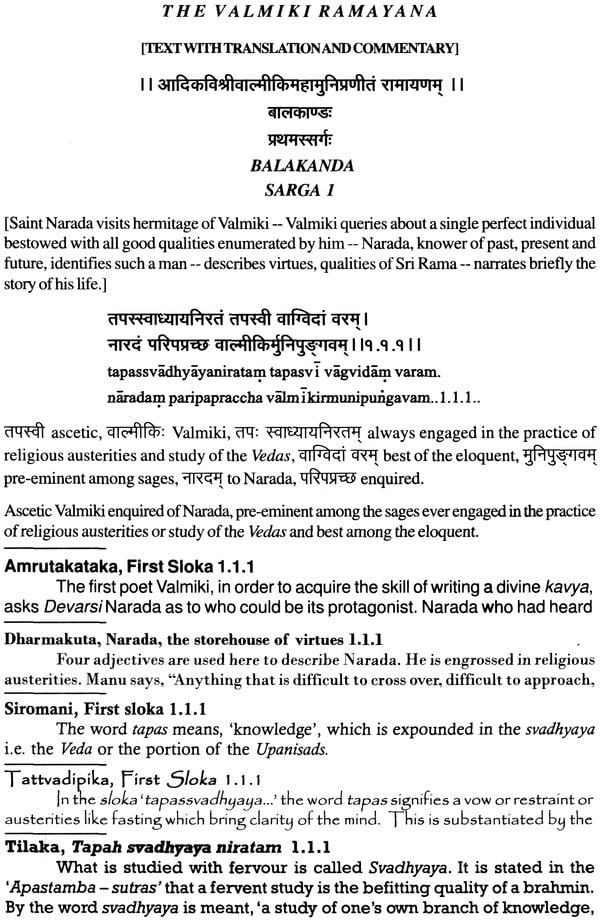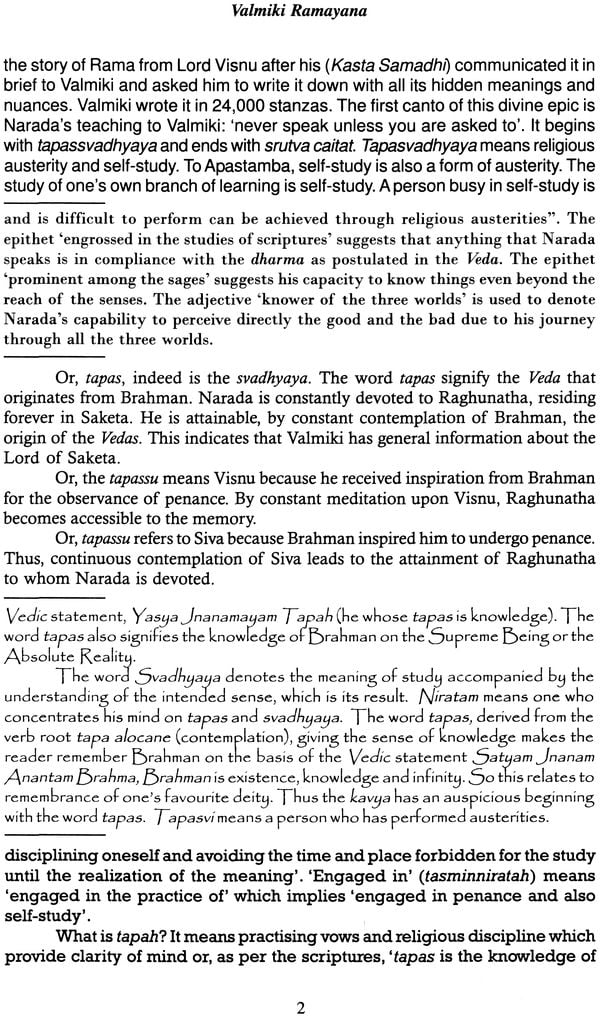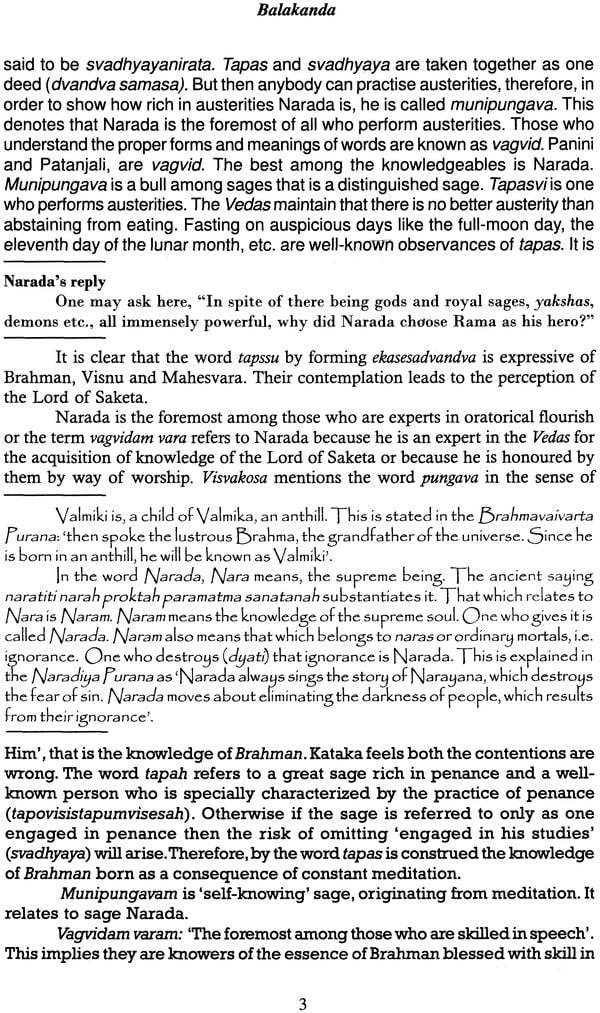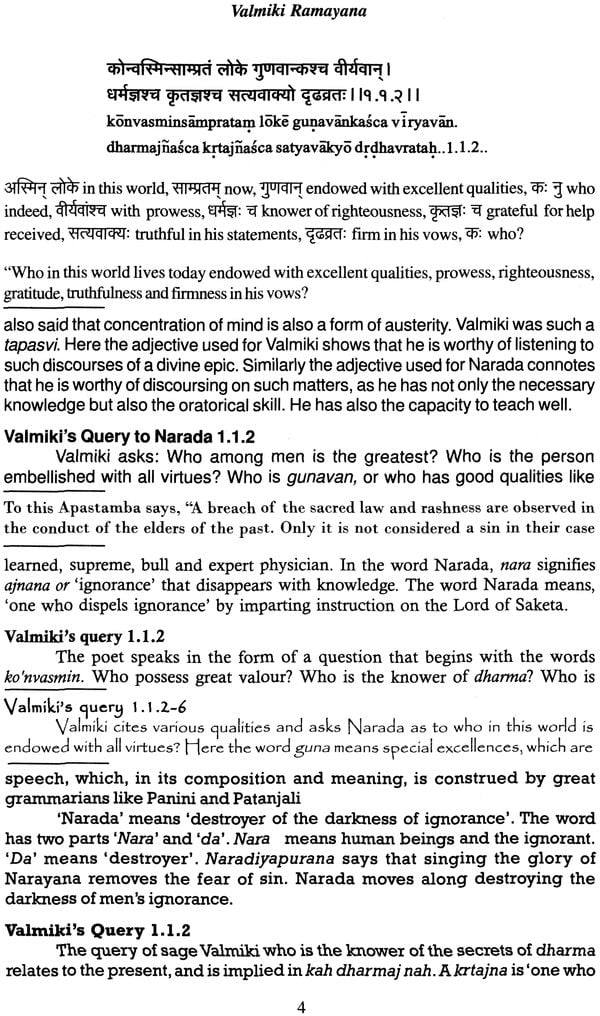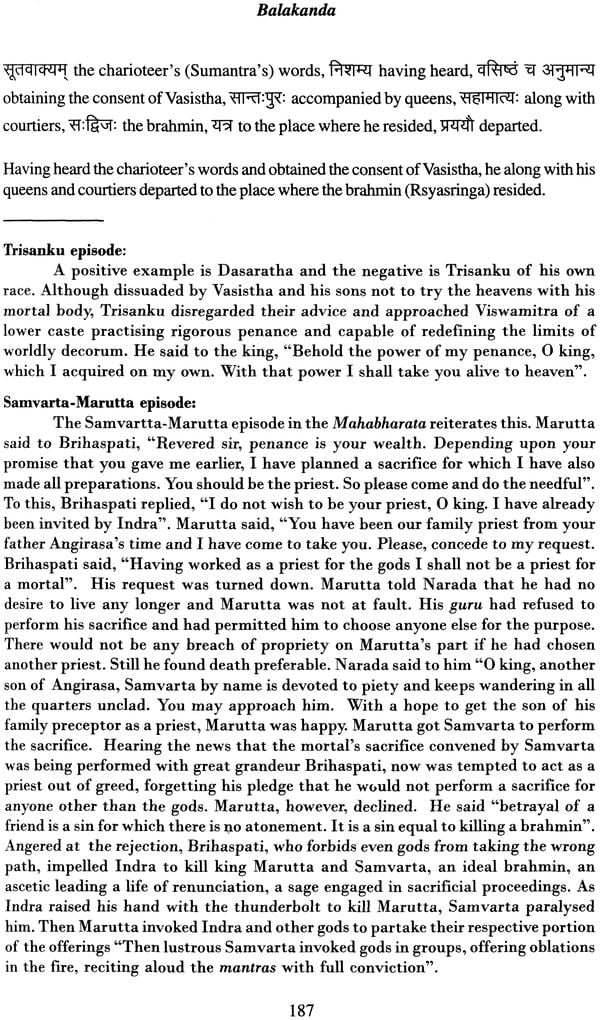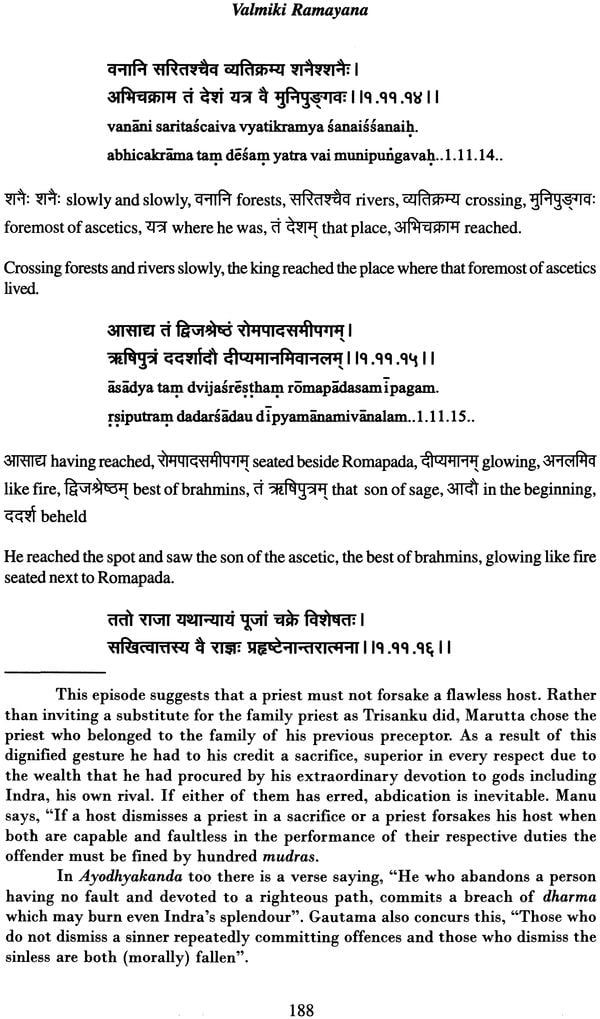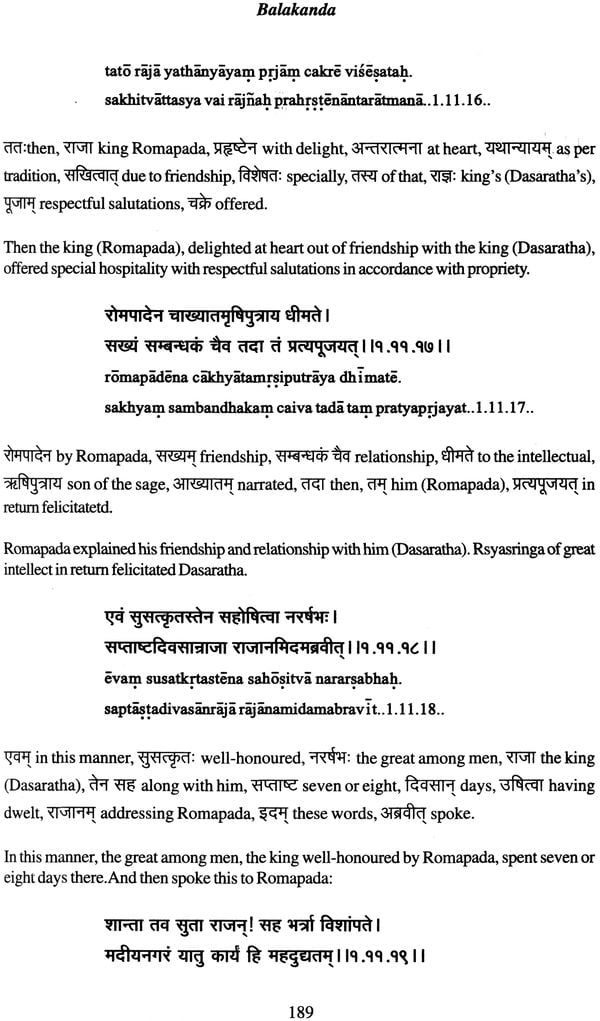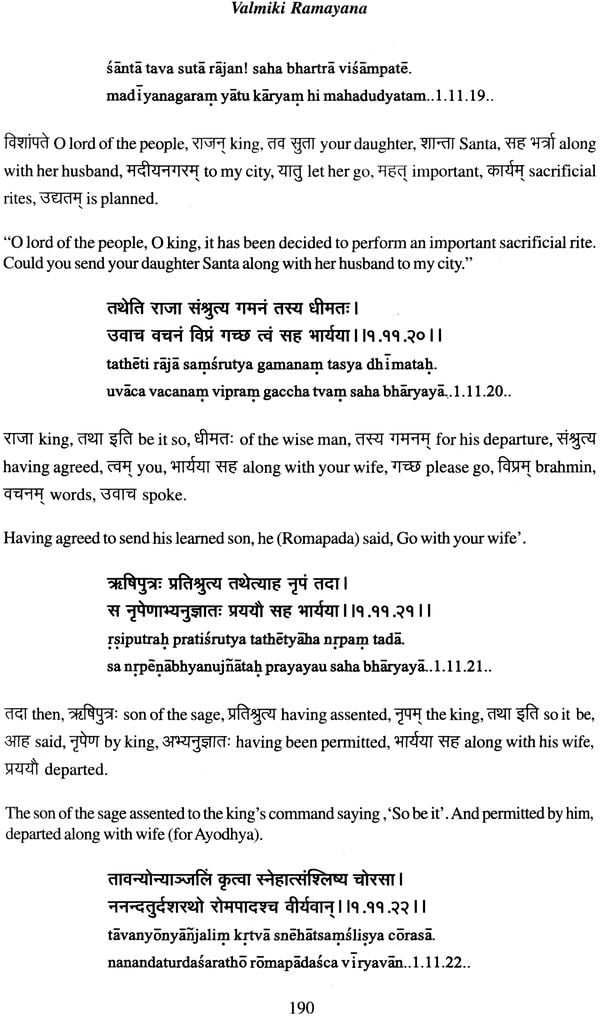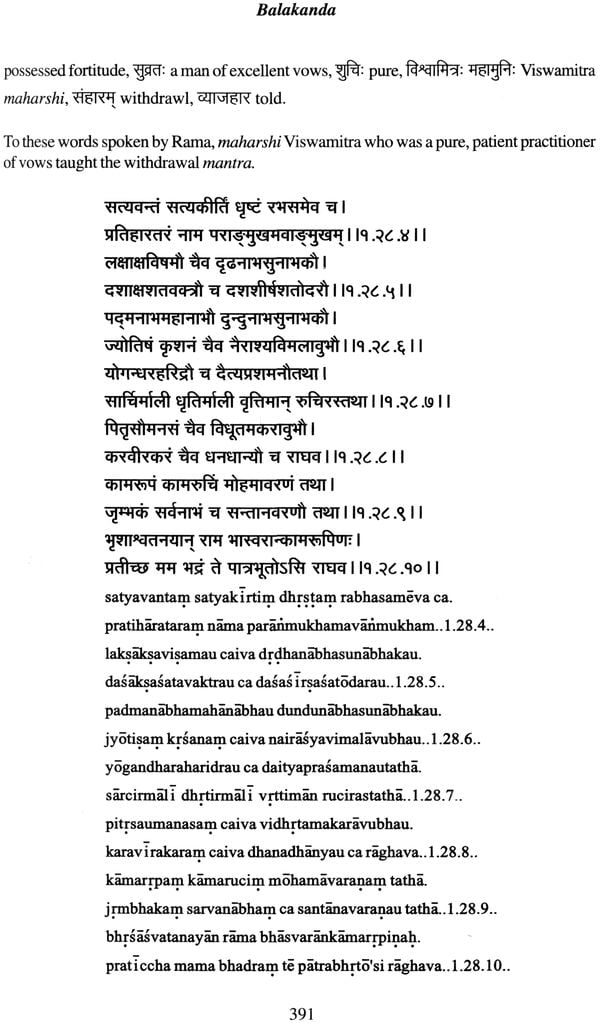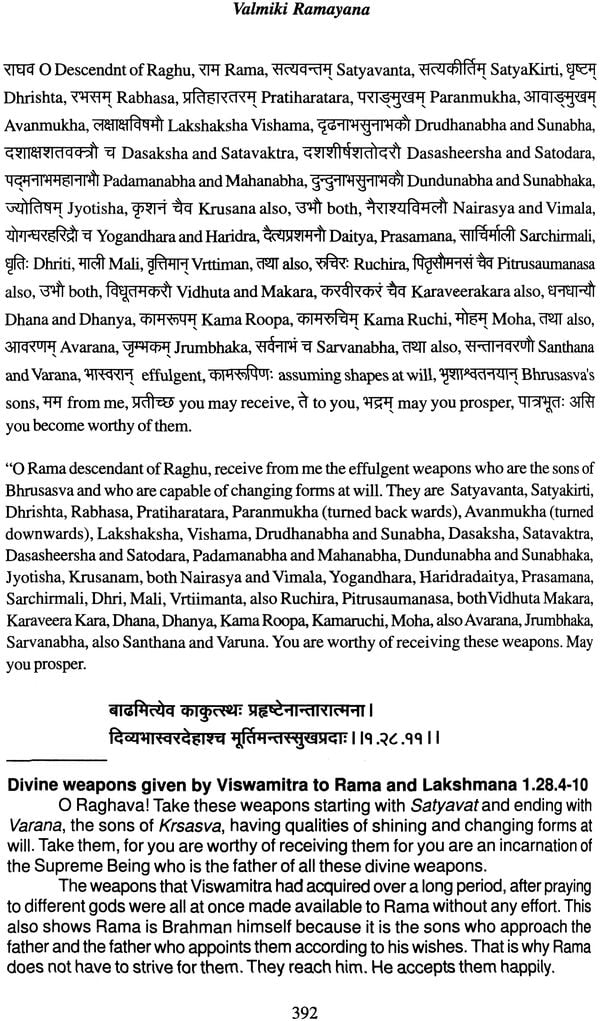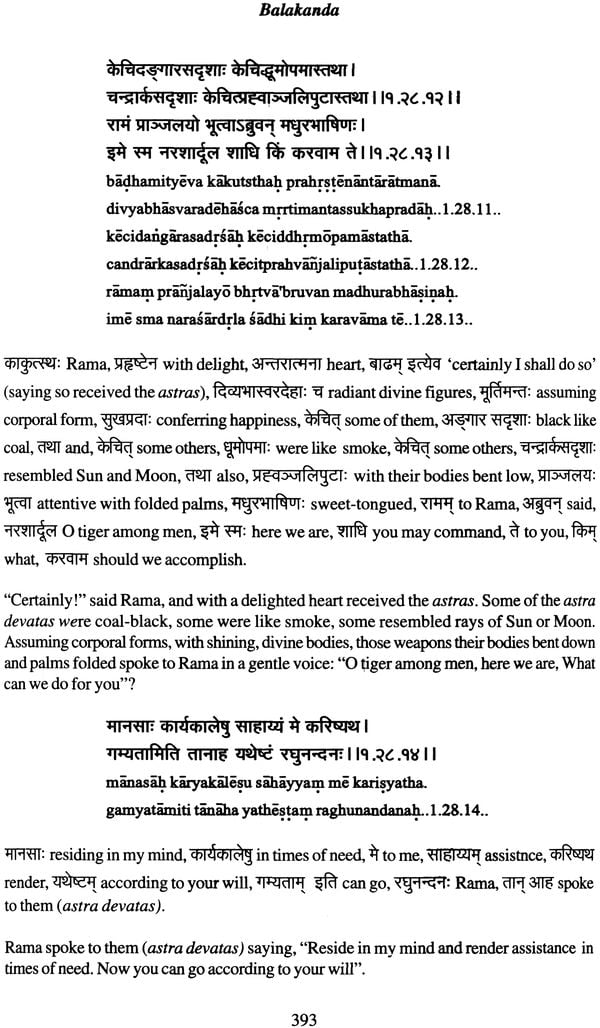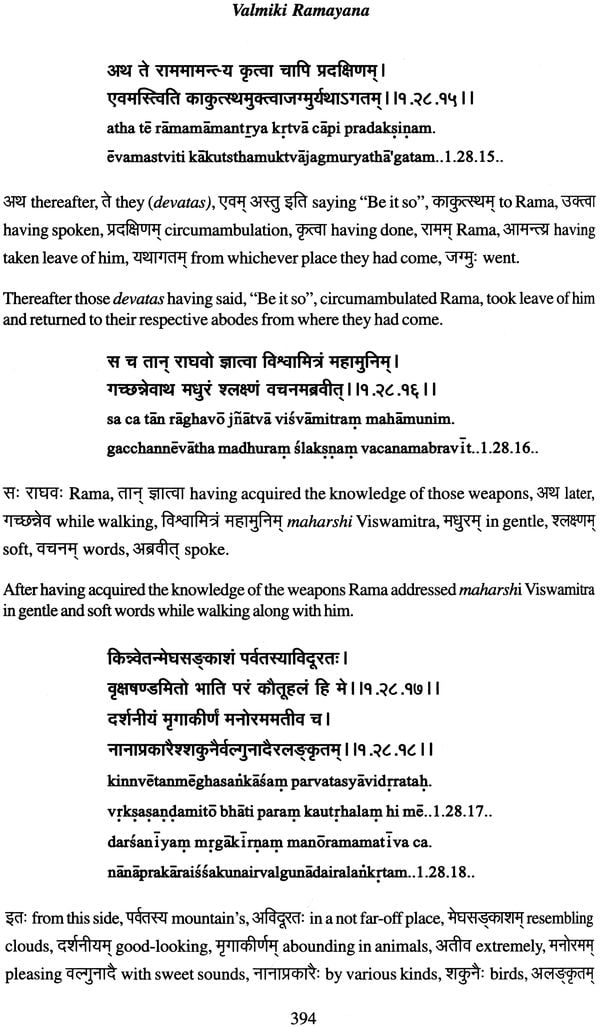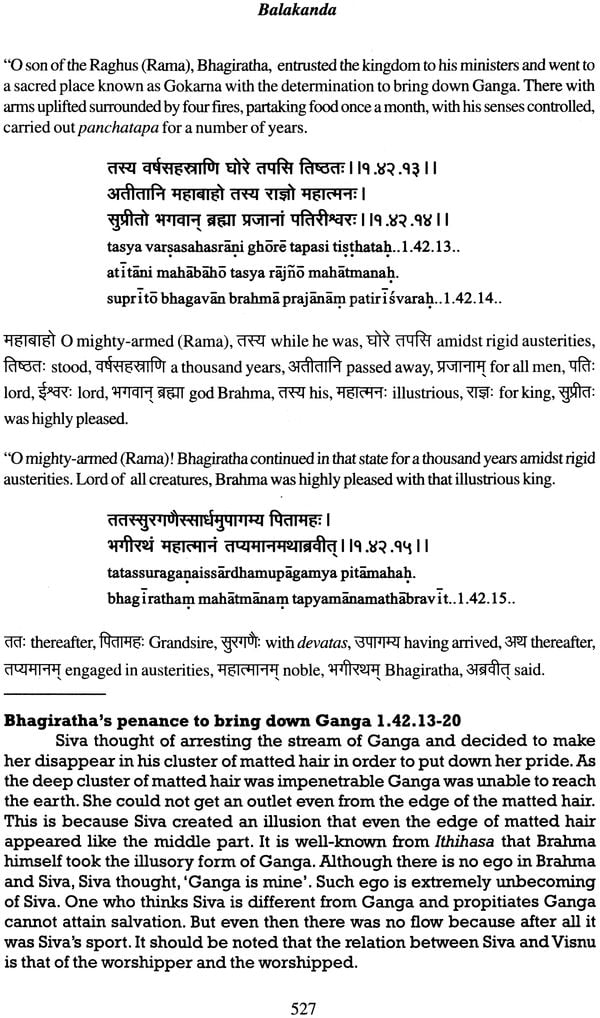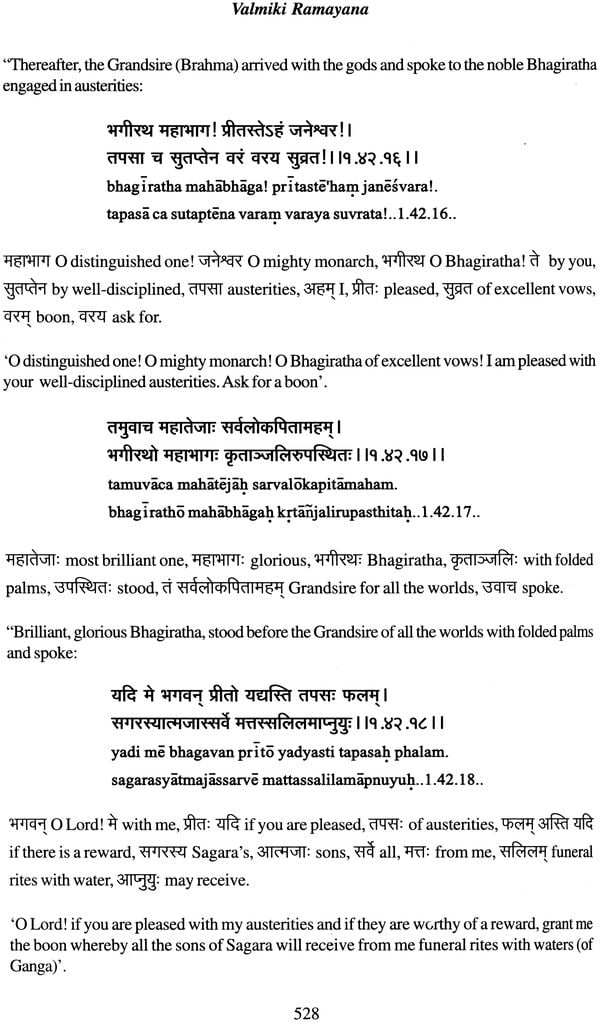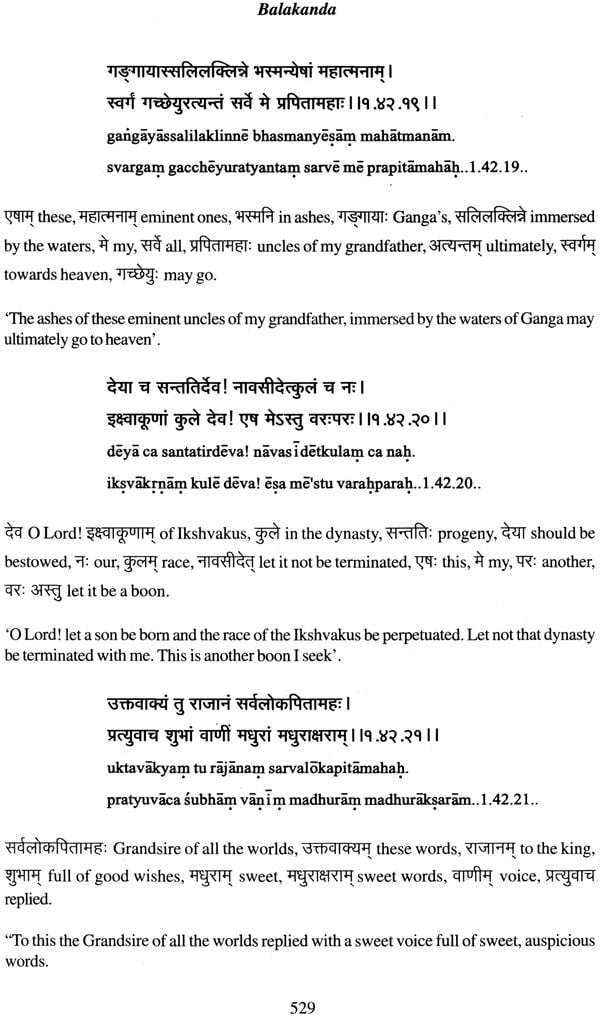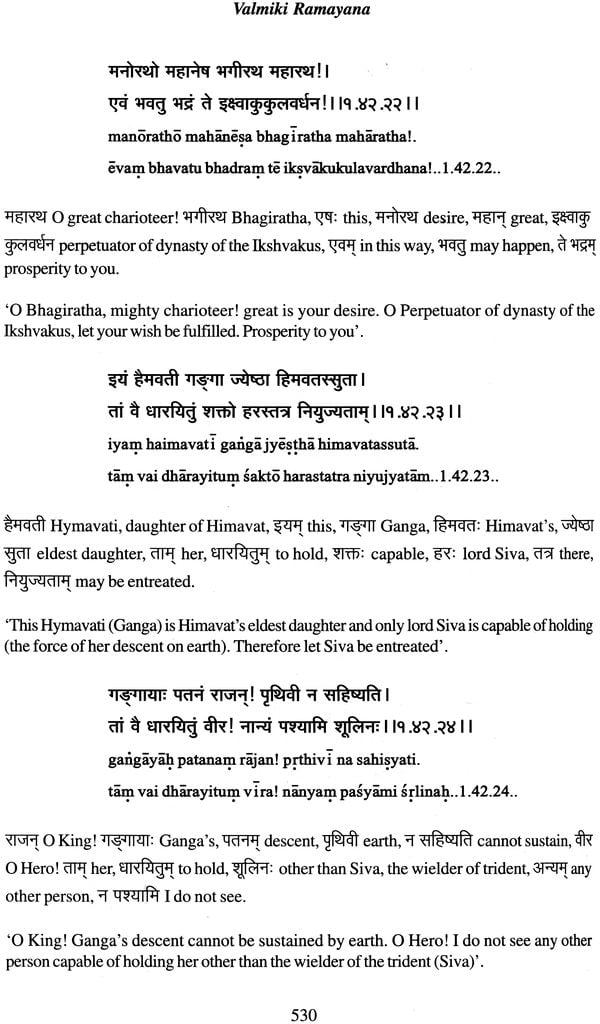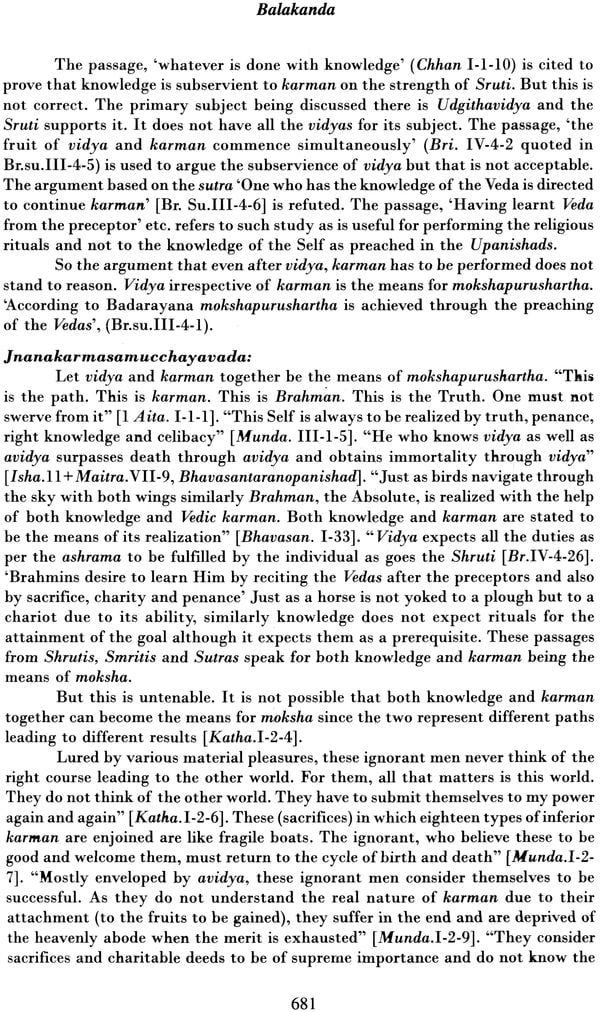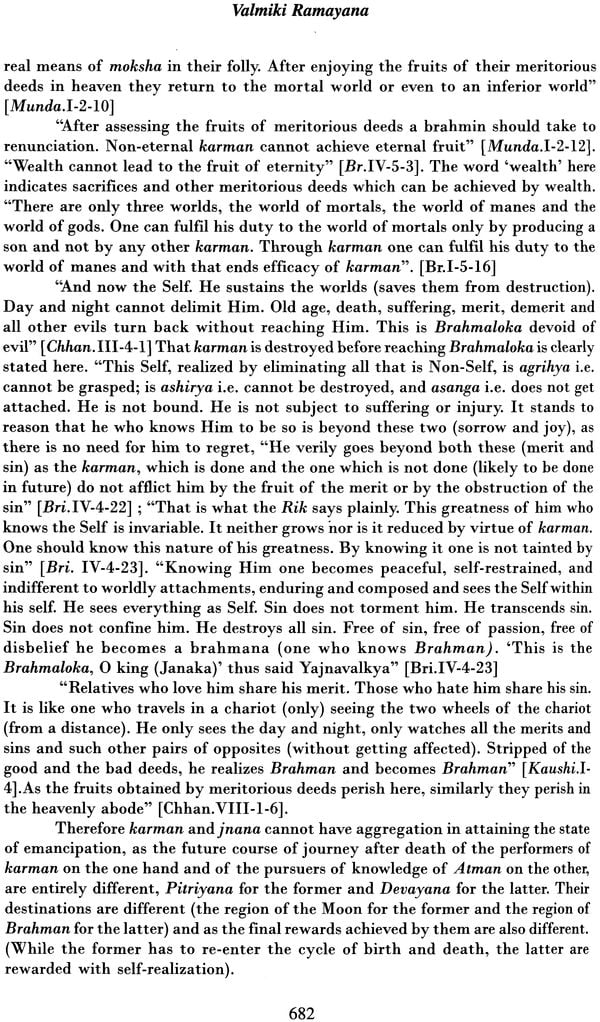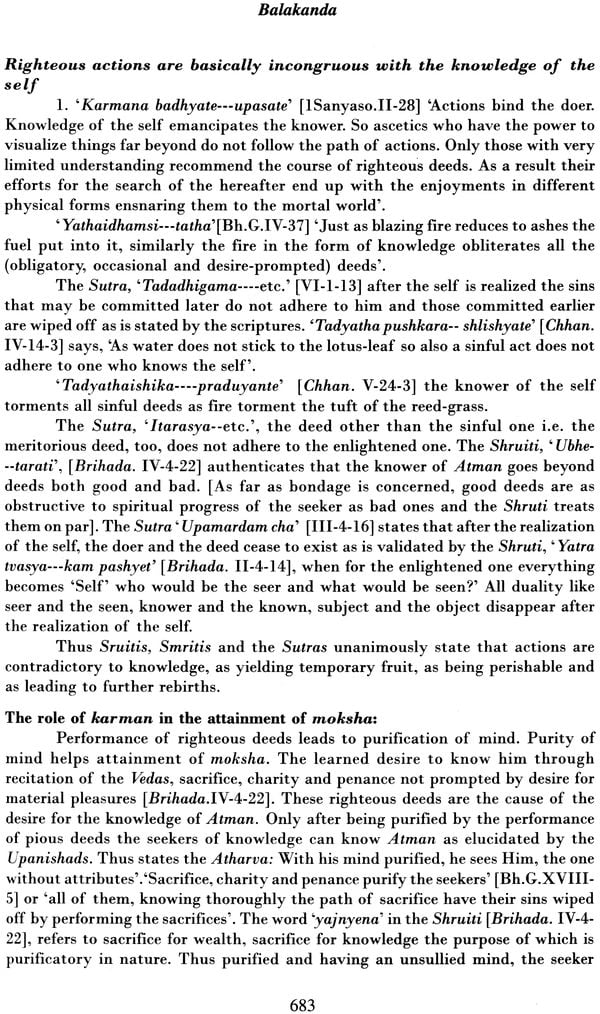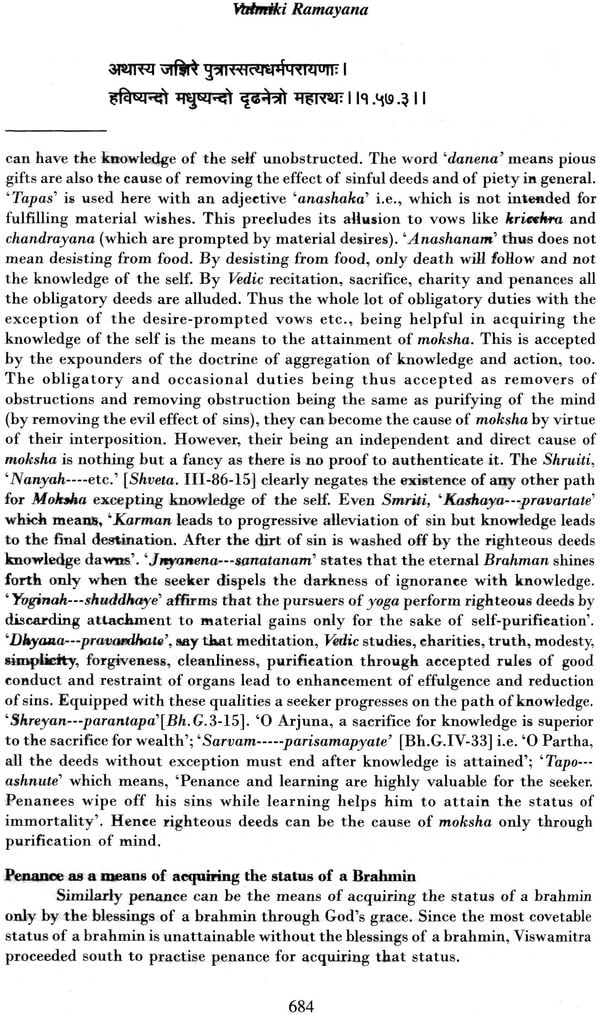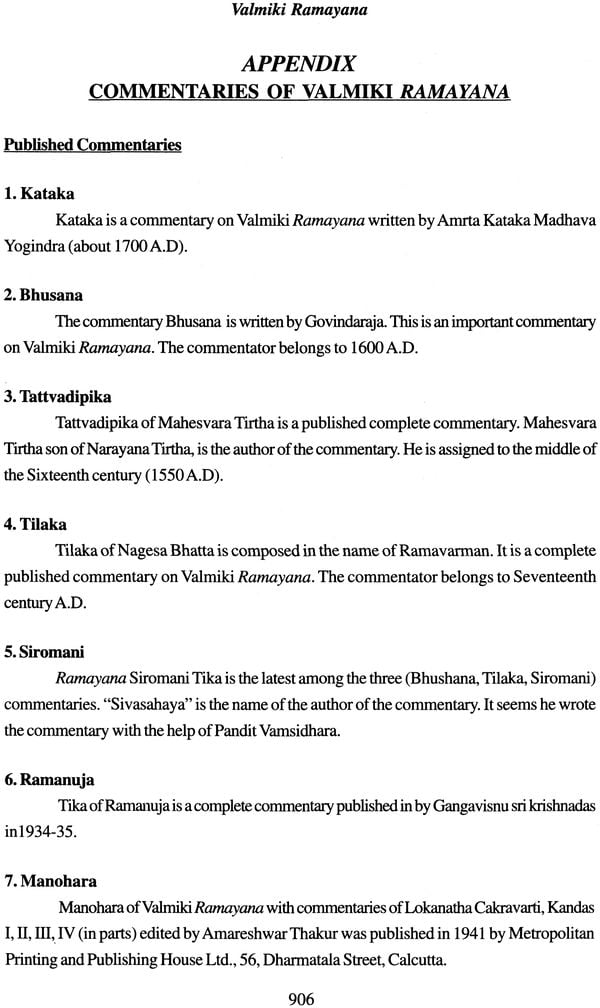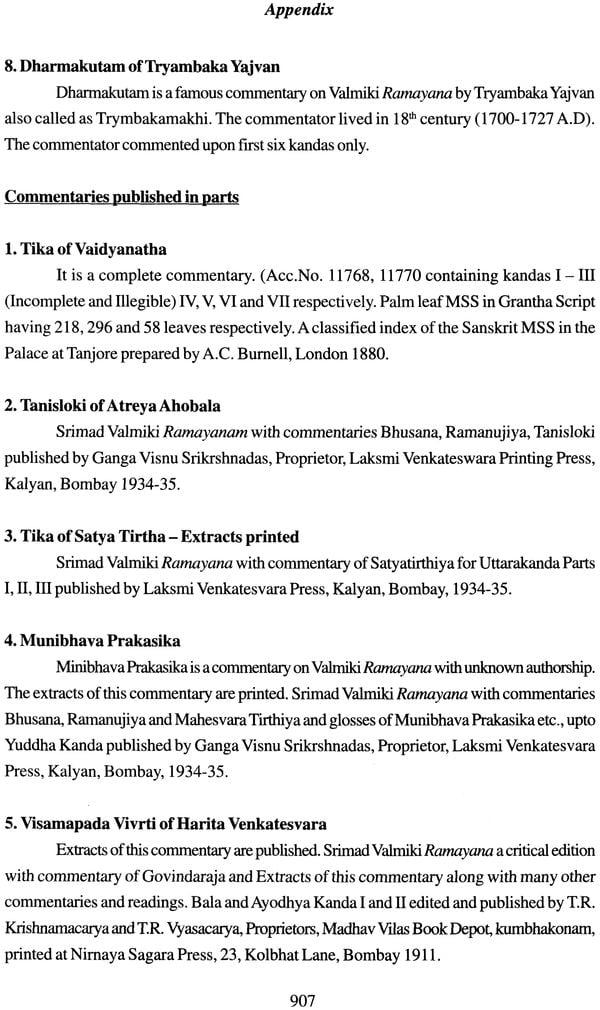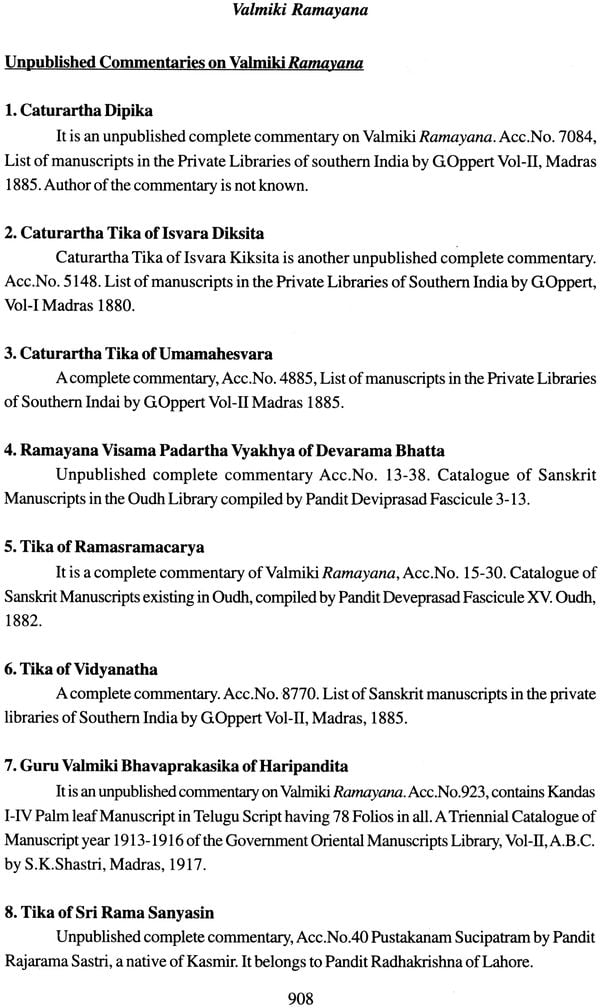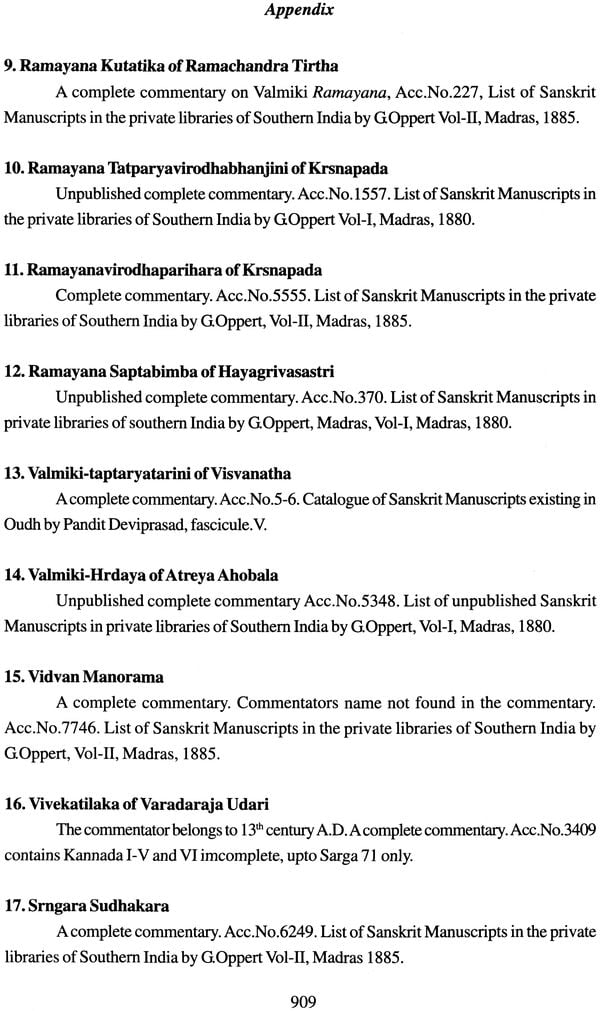
Valmiki Ramayana: Balakanda (With Sanskrit Text, Roman Transliteration, Word-to-Word Meaning and English Translation)
Book Specification
| Item Code: | NAC853 |
| Author: | Dr. P.M. Nayak &Dr. P. Geervani |
| Publisher: | Rashtriya Sanskrit Vidyapeetha, Tirupati |
| Language: | (With Sanskrit Text, Roman Transliteration, Word-to-Word Meaning and English Translation |
| Edition: | 2010 |
| Pages: | 932 |
| Cover: | Hardcover |
| Other Details | 11.5 Inch X 8.5 Inch |
| Weight | 2.21 kg |
Book Description
Prof. P.M. Nayak
A Sahitya Academy Award winner Prof. P.M. Nayak who ranked first in MA (Eng.) in Orissa in 1962 was principal in three degree colleges and registrar in two Universities of the province. He was elected member of the all India university Administrators association New Delhi in 1997.
Dr. Nayak chaired tow session in the European association of commonwealth language and literature studies Austria in 1993. He is at present director of the centrally sponsored Valmiki Ramayana project under Rastriya Sanskrit University, Tirupati, countries visited Germany U.K. Switzerland and Austria.
With publications in national and international journals which include commonwealth Novel in English, Virginia, Indian writing in English, Karnataka, Orissa Review, Orissa historical research Journal etc. Prof. Nayak’s voice of silence sonepur Durbar & Indian cultural traditions from Donaldson an American Orientalist some of his important translations include Pavanadutam by Kaviraj Dhoyi (EZCC Kolkata and Orissa Sahitya Academy) Utkal Laxmi by Gangadhar Meher (Sambalpur University) The Prophet B Gibran Ben Hur by Lewis Wallace (Vidyapuri, Cuttack) My Gipsy life by Padmasri LN Sahu (LN Sahu Memorial trust cuttack) Etc. the works he has edited are celestial infancy and other Essays on wordsworth (Anmol, New Delhi) Feminism and Indian English Fiction (PBD, Bereilly), The Voyage Inward (Bahri New Delhi) Confluence (Gyan, Books, New Delhi) Tales of our times (Cambridge) Inscriptions of Sonepur (Readworthy New Delhi) Songs of the soul (LN Sahu Memorial trust Cuttack) Sangita O Lokagita (EZCC Kolkata) Etc.
Prof. P. Geervani
Born in Tiruttani on 15th November 1936 in a traditional family devoted to Sri Rama completed B.Sc in 1955. M.Sc in 1960 and Ph.D. in foods and nutrition in 1977 from Madras University.
Started career as lecturer in Sri Padmavathi Women’s College in 1957 moved to the post of dietitian in 1960, and to Andhra Pradesh Agricultural University in 1968 as associate Prof. Held position of Prof. and dean in Andhra Pradesh Agricultural University Hyderabad till 1994. Took Up the position of Vice chancellor at Sri Padmavathi Mahila University From 1994 and retired in 1997.
Received international prize for research on technology for child Nutrition published over a hundred scientific papers in addition to few chapters in books. Selected as a fellow of united Nations University, Tokyo in 1986 as Fulbright scholar in 1987 as FAO consultant in 1991-94 and as fellow of national academy of Agriculture Science in 1999.
Inspired by the teachings of H.H. Swamy Chinmayananda studied Bhagavat Gita and Upanishads and participated in discussion at spiritual camps of Chinmaya Mission. Awakened to the beauty of epics by the enlightening discourses on Ramayan and Bhagavatam of H.H. Swamy Tejomayananda Global head at Chinmaya Mission decided to study Ramayana of Valmiki in detail. Motivated by the wonderful presentation of Human values and philosophy in the epic, decided to undertake translation of valmiki Ramayana in 2000 and monitor the project Valmiki Ramayana undertaken by Rashtriya Sanskrit Vidyapeetha Tirupati A.P.
It is gratifying to learn that the Rashtriya Sanskrit University Tirupati is shortly bringing out a critical edition of the Valmiki Ramayana along with its translation and transliteration in English. The project intends to incorporate canto wise summary and commentary by distinguished scholars of the 16th and 17th century India like Siromani Amrtakataka, Tilaka, Dharmakuta Etc.
The Ramayana is the world’s most ancient epic depicting the victory of truth and righteousness over devilry and falsehood. It teachers us the ideal code of conduct that one should adopt in life. This is fully illustrated in the life of Shri Ram who is perfection personified and therefore called Maryada Purushottama.
The story of Ramayana has spread all over the world particularly in the countries of South East Asia. It has shaped their society their civilization and culture like ours. It has left its deep imprint over their literature, dance, drama, music, sculpture, art and crafts. No other gift of India to the world is as precious as the Ramayana. In these disturbing times the appeal of the story of Ramayana is as relevant as before. A simple ethical living of peace and fraternity is what the world requires and not gross materialism and insatiable consumerism.
Ramayan is the oldest epic in world literature. It is a treasure house of knowledge and an inexhaustible mine for later poets and has a special place in Indian culture as well as Sanskrit literature. It is translated into all Indian languages and to several European Languages along with English. It is also rendered with variations in many South and South East countries since several centuries and they have adopted the epic in their music, dance, ballet, art and architecture.
It is believed that Valmiki Ramayana was put to writing around 500 A.D. It was told and retold since several centuries orally in an around India. Maharshi Valmiki is confident of its circulation among people until mountains stay erect on the earth.
Ramayana is known as a treatise of dharma. The four Purusharthas values of life viz, dharma, artha, kama and moksha are dealt here with utmost care. Kalidas the famous Sanskrit poet summarizes the values of life upheld by the kings of Ikshvaku dynasty as narrated by Valmiki. The Ramayana epic is strewn with exposition of values of life from great sages. The concept of dharma is depicted well through the conduct of various characters and more so by Rama. He deals with difficult situation with the ardent devotion of dharma. It gives a clear message that dharma will be victorious in the end. But those who want to stand by dharma may have to pay the price in order to achieve benefit for the entire society. The path of dharma in open for fearless and noble people.
It is an arduous and yet rewarding experience for academicians and scholars working under Ramayana Project to give comprehensive view of the entire epic along with its five commentaries. The idea of our attempt is to present translation of the text of Valmiki Ramayanam with word order and meaning of each verse followed by translation of verse in English. It is our intention to introduce through electronic and print media Valimiki Ramayana and its commentaries in English to the modern youth interested in ancient scriptures who have missed the traditional learning and Sanskrit language.
Although Valmiki Ramayana is in vogue all over the country three well known versions namely the Northwest East and Southern versions are more popular. The Southern recession has been selected for the present translation. The best of the commentaries of Valmiki Ramayana being written in Sanskrit is not to the understanding of many readers. More over the influence of English on the present generation handicaps one to understand the Sanskrit commentaries.
Considering the importance of highlighting the philosophical thoughts values and social ideals internalized in the commentaries of Ramayana it is also attempted to translate selected commentaries into English (Though there are some more important commentaries). Several authors have written commentaries on Valmiki Ramayana which are difficult to understand for all. The authors represent different schools of Philosophy. These commentaries enriched Indian philosophy. The commentaries selected for translation for the present are Amrithakataka, Dhramakutam, Tattvadipika, Tilaka and Siromani. The English translation of commentaries has been given for important subject on which commentary is given.
Indian literary tradition holds Valmiki as the first poet (Adikavi) and Ramayana as the first epic, Adikavya Valmiki is the first path maker for the sweet expression of poetry. He provided inspiration for all classical poets and his influence is seen in Sanskrit literature in Poems plays and Kavyas. Even though Valmiki Ramayana has been composed in classical Sanskrit and not intelligible to the unlettered yet due to the efforts made by oral expounders it was made understandable to the masses in rural India Lava and Kusa are the first expounders of Ramayana and great Valmiki himself trained them. This practice of popular exposition of Ramayana continued through centuries making illiteracy no bar for reading Ramayana. Keeping in view the melody of Ramayana an attempt is made for audio rendering of the verses to make the reader experience the melody of the poems. There is a practice of reading Ramayana. Keeping in view the melody of Ramayana an attempt is made for audio rendering of the verses to make the reader experience the melody of the poems. There is a practice of reading Ramayana or part of Ramayana daily particularly Sundara Kanda so that not only professional exponents of the epic but also large number of people know Valmiki Ramayana by heart. Many people know to repeat off hand Sundara Kanda thus the text is retained in its original form in India.
If a poem has contribute substantially to keeping in Indian culture alive its Ramayana Rama the warrior prince is a hero a likeable pleasing god man later came to be looked upon as god more particularly with the Vedic gods receding into the back ground. Rama became a by word. The social ideals family relationships introduced by Valmiki made it popular over other stories of the past such as Savitri Satyavan Nala-Damayanti Tapti Samvarana and Vasavadatta Udayana. The description of human relationship in royal households of Ayodhya Kishkinda and Lanka is unique. Ramayana is a book of dharma and Rama is an embodiment of dharma and a paradigm of an ideal man. Ramayana clearly illustrates that arha and kama can be enjoyed with in the legitiamate bounds of dharma.
The story of Rama and Sita the dharma by which they lived and the adharma they shunned express a value system basic to much education in India. Hope this presentation produces firmer devotion to Rama and commitment to dharma which each of us is called on to practice.
| 1 | Sarga 1 | 1 |
| 2 | Sarga 2 | 65 |
| 3 | Sarga 3 | 88 |
| 4 | Sarga 4 | 103 |
| 5 | Sarga 5 | 119 |
| 6 | Sarga 6 | 131 |
| 7 | Sarga 7 | 142 |
| 8 | Sarga 8 | 153 |
| 9 | Sarga 9 | 164 |
| 10 | Sarga 10 | 172 |
| 11 | Sarga 11 | 183 |
| 12 | Sarga 12 | 195 |
| 13 | Sarga 13 | 203 |
| 14 | Sarga 14 | 216 |
| 15 | Sarga 15 | 235 |
| 16 | Sarga 16 | 249 |
| 17 | Sarga 17 | 261 |
| 18 | Sarga 18 | 275 |
| 19 | Sarga 19 | 300 |
| 20 | Sarga 20 | 308 |
| 21 | Sarga 21 | 320 |
| 22 | Sarga 22 | 330 |
| 23 | Sarga 23 | 339 |
| 24 | Sarga 24 | 347 |
| 25 | Sarga 25 | 359 |
| 26 | Sarga 26 | 367 |
| 27 | Sarga 27 | 381 |
| 28 | Sarga 28 | 390 |
| 29 | Sarga 29 | 397 |
| 30 | Sarga 30 | 409 |
| 31 | Sarga 31 | 418 |
| 32 | Sarga 32 | 427 |
| 33 | Sarga 33 | 437 |
| 34 | Sarga 34 | 446 |
| 35 | Sarga 35 | 454 |
| 36 | Sarga 36 | 463 |
| 37 | Sarga 37 | 474 |
| 38 | Sarga 38 | 485 |
| 39 | Sarga 39 | 494 |
| 40 | Sarga 40 | 503 |
| 41 | Sarga 41 | 513 |
| 42 | Sarga 42 | 523 |
| 43 | Sarga 43 | 532 |
| 44 | Sarga 44 | 546 |
| 45 | Sarga 45 | 556 |
| 46 | Sarga 46 | 572 |
| 47 | Sarga 47 | 581 |
| 48 | Sarga 48 | 589 |
| 49 | Sarga 49 | 601 |
| 50 | Sarga 50 | 608 |
| 51 | Sarga 51 | 617 |
| 52 | Sarga 52 | 626 |
| 53 | Sarga 53 | 634 |
| 54 | Sarga 54 | 645 |
| 55 | Sarga 55 | 654 |
| 56 | Sarga 56 | 663 |
| 57 | Sarga 57 | 677 |
| 58 | Sarga 58 | 692 |
| 59 | Sarga 59 | 701 |
| 60 | Sarga 60 | 710 |
| 61 | Sarga 61 | 721 |
| 62 | Sarga 62 | 730 |
| 63 | Sarga 63 | 740 |
| 64 | Sarga 64 | 749 |
| 65 | Sarga 65 | 757 |
| 66 | Sarga 66 | 773 |
| 67 | Sarga 67 | 782 |
| 68 | Sarga 68 | 792 |
| 69 | Sarga 69 | 799 |
| 70 | Sarga 70 | 806 |
| 71 | Sarga 71 | 821 |
| 72 | Sarga 72 | 829 |
| 73 | Sarga 73 | 841 |
| 74 | Sarga 74 | 856 |
| 75 | Sarga 75 | 865 |
| 76 | Sarga 76 | 881 |
| 77 | Sarga 77 | 894 |
| 78 | Appendix | 906 |
